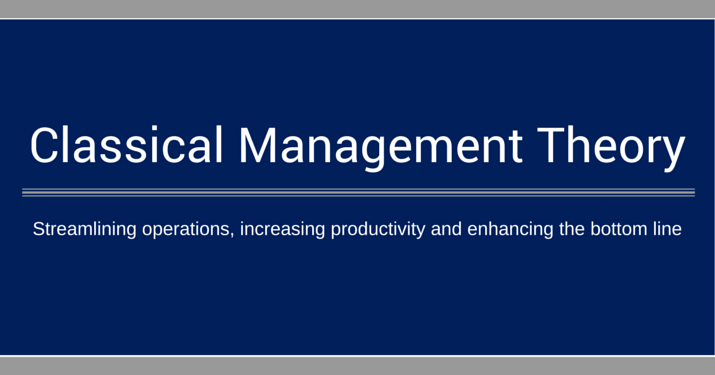What is Classical Management Theory?
Last Updated May 5, 2022

Classical management theory is based on the belief that workers only have physical and economic needs. Unlike more modern workplace management theories, it does not take into account social needs or job satisfaction. Instead, classical management theory advocates a specialization of labor, centralized leadership and decision-making, and profit maximization.
Designed solely to streamline operations, increase productivity and enhance the bottom line, this management theory arose in the late 19th century and gained prominence through the first half of the 20th century. While not as widely subscribed to in modern times, the classical management theory offers some principles that remain valid, to an extent, in small business settings in regard to manufacturing.
3 Main Concepts of the Classical Management Theory
Classical management theory outlines an ideal workplace as one that rests on three main concepts: hierarchical structure, specialization and incentives.
Hierarchical Structure
Under the classical model, workplaces are divided into three distinct layers of management in a hierarchical structure. At the very top are the owners, board of directors and executives that set the long-range objectives for a firm. Middle management takes on the responsibility of overseeing supervisors while setting goals at the department level to fit within the confines of the managers’ budget. At the lowest level of the chain are supervisors, who manage day-to-day activities, address employee problems and provide training.
Specialization
The classical management theory involves an assembly line view of the workplace in which large tasks are broken down into smaller ones that are easy to accomplish. Workers understand their roles and typically specialize in a single area. This helps increase productivity and efficiency while eliminating the need for employees to multi-task.
Incentives
The classical theory believes that employees are motivated by financial rewards. It proposes that employees will work harder and be more productive if they are awarded incentives based on their work. Employers who can motivate their employees with incentives may be able to achieve increased production, efficiency and profit.
Autocratic Leadership Model in the Classical Theory
The autocratic leadership model is the central part of the classical management theory. In an autocratic system, there is no need to consult large groups of people for decisions to be made. A single leader makes a final decision that is communicated downward for all employees to follow. This management style can be beneficial when decisions need to be made quickly by one leader, rather than a group of company officials.
Strengths of the Classical Management Theory
While not typically used in today’s workplaces, the classical management theory does have some strong points. They include:
- A clear structure for management, its functions and operations
- The division of labor that can make tasks easier and more efficient to accomplish, which can enhance productivity
- Clear definition of employee roles and tasks with little left to guesswork
Flaws in the Classical Model
When the classical theory is put into action, companies can see their production numbers increase. There are, however, some flaws that make this particular management model less than attractive in workplaces. These pitfalls include:
- By attempting to predict and control human behavior, this management theory overlooks the importance of human relations and creativity.
- In essence, the classical model views workers almost as machines but fails to take into account what job satisfaction, employee input and morale can bring to the workplace.
- The reliance on prior experience and the ability to apply the classical model almost solely to manufacturing settings is another drawback of this management theory.
The classical management theory can help streamline manufacturing operations where high productivity is a must. However, it fell out of favor after the rise of other management theories and the human relations movement, which sought to gain a better understanding of the human motivation for productivity. Although some of its facets are viable for certain circumstances, the classical management theory generally does not translate well to workplaces today.
Through educational leadership programs, today’s business leaders can learn about modern management theories that will help them guide colleagues toward increasing productivity and meeting organizational goals.
